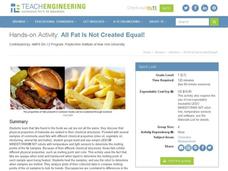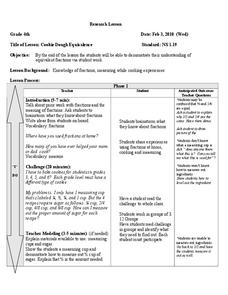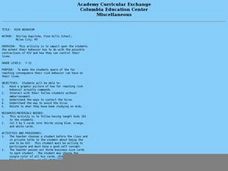Curated OER
Sippin' on Smoothies
Why is calcium good for the body? Where is it stored? Young chefs discover the importance of calcium and review a list of foods that are rich in the material. They then make delicious smoothies high in calcium! Teaching kids how to make...
Curated OER
Energy Balance 101 - Setting a Smart Goal
Help your pupils learn how to set realistic attainable goals. This activity helps them practice how to write a specific goal that is measurable. Of course, the topic here is energy in and energy out. We all need help setting goals in a...
BioEd Online
Serving Sizes
When it comes to eating a balanced diet, portion control is paramount, but what is the difference between the serving size on the nutrition facts label and a portion as determined by the USDA? In a comprehensive look at portion control,...
Cengage Learning
COVID-19: How Do I Protect Myself?
Since COVID-19, the novel coronavirus, is so easily transmitted, we must take preventative measures to keep others and ourselves from getting sick. Scholars learn about these measures in a lesson that introduces information by way of an...
Curated OER
Observation Milk Fat Lesson
Turn your class loose to experiment with the different fat content in skim milk, whole milk, half and half, and heavy cream. This is a visually vibrant experiment, as learners drip food coloring on the surface of the products and measure...
Curated OER
Aerobic/Anaerobic Respiration
Both aerobic and anerobic respiration are introduced in this succinct PowerPoint. The chemical equations for both are included. The last slides give instructions for a lab activity in which pupils use a gas sensor to measure the...
Champions for Change
How Many Cups Do I Need?
Does an apple a day really keep the doctor away? Find out by browsing through a variety of handouts and learning the recommended daily amounts of fruits and vegetables for good health. Learners will read and discuss how to visually...
Baylor College
How Much Water Do Humans Need?
Physical or life science learners measure the amounts of water eliminated by intestines and the urinary system, and the amounts lost via respiration and perspiration. In doing so, they discover that the body's water must be replenished...
Baylor College
What's Is Soil Made Of?
It's time to roll up those sleeves and get a little dirty in the second lesson plan of this series on the science of food. Investigate where plants and animals get the minerals they need to live in this two-part exploration of soil....
Council for the Curriculum, Examinations and Assessment
Health and the Whole Person
Health is more than measuring your blood pressure and eating nutritious foods. Eighth graders discuss the factors that play into an individual's health, including spirituality, social life and friendships, emotional stability, cognitive...
Teach Engineering
All Fats Are Not Created Equal
Apply robotics to connect physical properties to chemical properties. Future engineers use robots to determine the melting points of various fats and oils. The robots can do this by measuring the translucency of the fats as they heat up.
Bethel School District
Health Triangle Self Assessment
Measure health as a triangle, with each side representing different aspects of health: physical, emotional/mental, and social. High schoolers complete a self-assessment of their health in all three areas before scoring their progress and...
Purdue University
Well-Being: Dimensions of Wellness
New ReviewA unit on well-being begins with participants completing a self-assessment worksheet. After reflecting on the results, individuals set well-being goals for themselves that are SMART (Specific, Measurable, Attainable, Relevant, and...
Curated OER
Cookie Dough Equivalence
There's nothing better than using a cooking lesson to teach about fractions! In this clever lesson, young chefs must determine the proper amounts of ingredients while using a standard measuring cup. The recipe is embedded in the plan,...
Curated OER
Exploring Dietary Guidelines and Healthy Eating Patterns
How nutritious is a tiny lollipop? Pass them out to your class as they view a PowerPoint presentation on the basics of nutrition. The students measure and record their weight and height and then carry out a computer activity using their...
Curated OER
Manufacture of Cheese
Pupils examine the steps and safety procedures in the cheese making process. They make and taste a variety of cheeses comparing their properties.
Curated OER
Risk Behavior: HIV/AIDS
Bring to life the health risks of unsafe sex and drug use. Participants are involved in a simulation they don't understand until the end. One pupil is "in the know", secretly playing the role of being HIV-positive. Everyone else...
Curated OER
Aerobic And Anaerobic Activity
Third graders engage in the study of aerobic and anaerobic activities. They discuss the differences in the type of exercises involved. Students identify the types of activities they enjoy based upon the information given. Then students...
Curated OER
What Is Important to Me?
Students respond to prompt with awareness of personal value of possessions. They list the criteria used to determine worth and value. They listen and ask questions or add comments and check their own measures of value with those the...
Curated OER
Controlling the Pandemic: Public Health Focus
Learners examine global issues centered around HIV and AIDS. In this health science lesson, students compare and analyze public health measures and factors that affect the treatment of HIV/AIDS. They examine the role of socioeconomic...
Curated OER
Calculating Your Foodometer
Students explore environmental issues by completing a food production class activity. For this carbon footprint lesson, students discuss the types of foods they eat, where they come from and what types of methods are used to transport...
Curated OER
Target Heart Rate
This accompanies a lesson on how various activities affect heart rate. Young learners identify resting heart rate and target heart rate. They do some physical activities to measure their heart rates for each of those activities. They...
Curated OER
Your Energy Balance Goal!
This is the last lesson plan in the series put out by Together Counts on health. This activity has youngsters setting goals to keep their energy balanced by making excellent eating and activity choices. They may need a little help making...
Baylor College
Safe Food Preparation
Who doesn't love ice cream? Make this delicious dessert with your class while learning about food preparation in the tenth lesson of this series. Teach about the importance of cleanliness and proper cooking techniques in order to avoid...
Other popular searches
- Customary Measurement
- Math Measurement
- Liquid Measurement
- Measuring Angles
- Nonstandard Measurement
- Capacity Measurement
- Standard Measurement
- Linear Measurement
- Angle Measurement
- Measurement Length
- Geometry Measurement
- Units Measurement

























